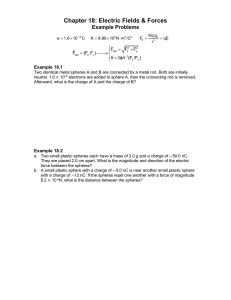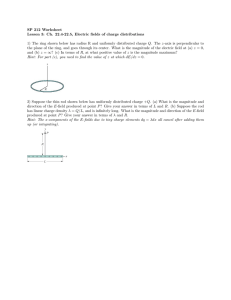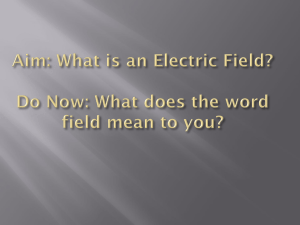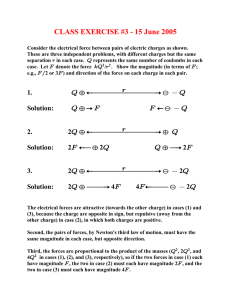AP Physics Test - Electric Fields
advertisement
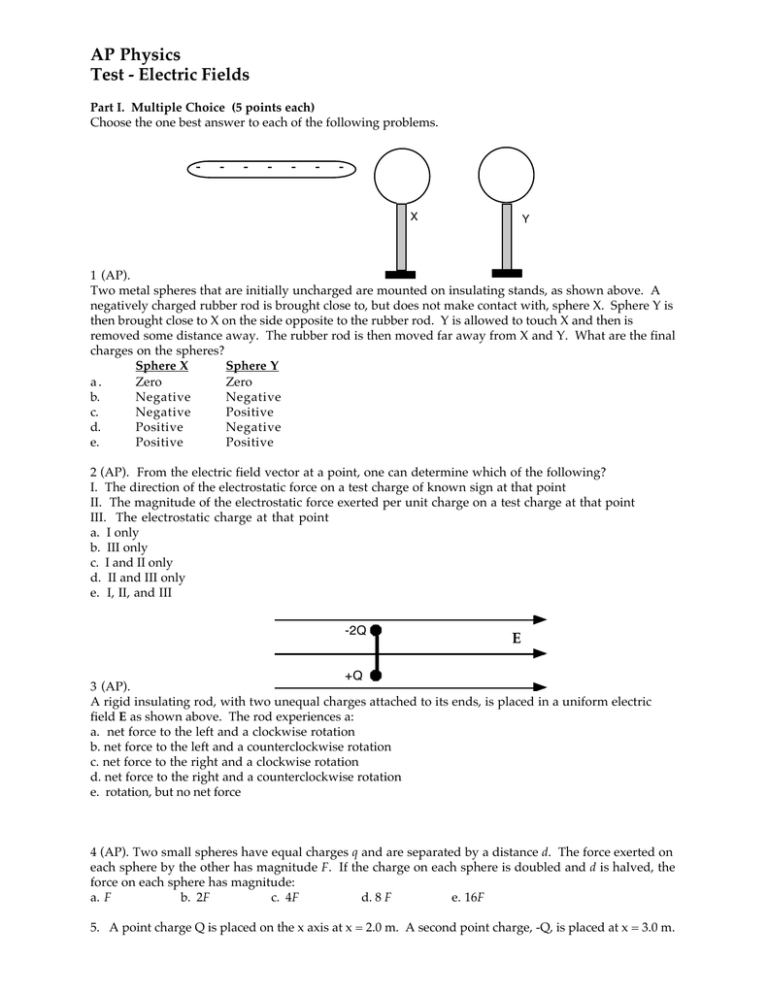
AP Physics Test - Electric Fields Part I. Multiple Choice (5 points each) Choose the one best answer to each of the following problems. - - - - - - X Y 1 (AP). Two metal spheres that are initially uncharged are mounted on insulating stands, as shown above. A negatively charged rubber rod is brought close to, but does not make contact with, sphere X. Sphere Y is then brought close to X on the side opposite to the rubber rod. Y is allowed to touch X and then is removed some distance away. The rubber rod is then moved far away from X and Y. What are the final charges on the spheres? Sphere X Sphere Y a. Zero Zero b. Negative Negative c. Negative Positive d. Positive Negative e. Positive Positive 2 (AP). From the electric field vector at a point, one can determine which of the following? I. The direction of the electrostatic force on a test charge of known sign at that point II. The magnitude of the electrostatic force exerted per unit charge on a test charge at that point III. The electrostatic charge at that point a. I only b. III only c. I and II only d. II and III only e. I, II, and III -2Q E +Q 3 (AP). A rigid insulating rod, with two unequal charges attached to its ends, is placed in a uniform electric field E as shown above. The rod experiences a: a. net force to the left and a clockwise rotation b. net force to the left and a counterclockwise rotation c. net force to the right and a clockwise rotation d. net force to the right and a counterclockwise rotation e. rotation, but no net force 4 (AP). Two small spheres have equal charges q and are separated by a distance d. The force exerted on each sphere by the other has magnitude F. If the charge on each sphere is doubled and d is halved, the force on each sphere has magnitude: a. F b. 2F c. 4F d. 8 F e. 16F 5. A point charge Q is placed on the x axis at x = 2.0 m. A second point charge, -Q, is placed at x = 3.0 m. If Q = 40 µC, what is the magnitude of the electrostatic force on a 30 µC charge placed at the origin? a. 7.2 N b. 3.9 N c. 1.5 N d. 14 N e. 8.1 N y +q -d + D +q A d B + 2d C 3d x E 6 (AP). Two positive charges of magnitude q are each a distance d from the origin A of a coordinate system as shown above. At which of the following points is the electric field most in magnitude? a. A b. B c. C d. D e. E 7. Identical 4.0 nC charges are placed at the vertices of an equilateral triangle with 1.0m sides. What is the magnitude of the electric field at the midpoint of any of the three sides? a. 84 N/C b. 36 N/C c. 60 N/C d. 48 N/C e. 42 N/C 8. Assuming that the charges are evenly distributed throughout each of the following charge sources, draw a field diagram for the surrounding area. +2 Q +8 Q -4 Q Part II. Free Response (15 points each) 9. A rod 14.0 cm long is uniformly charged and has a total charge of -22.0 µC. Determine the magnitude and direction of the electric field along the axis of the rod at a point 36.0 cm from its center. 10. A uniformly charged insulating rod of length 14.0 cm is bent into the shape of a semicircle. The rod has a total charge of -7.50 µC. a. What is the linear charge density of the rod? b. Develop an integral expression that could be used to evaluate the electric field at the center of the circle. c. Using your expression from Part b above, calculate the magnitude and direction of the electric field at the center of the circle. length = 20.0 cm 15° E = 1.0 x 103 i N/C m = 2.00 g 11. A small 2.00 g plastic ball is suspended by a 20.0 cm long string in a uniform electric field as shown above. The ball is in equilibrium when the string makes a 15.0° angle with the vertical. a. Determine the tension in the string. b. What is the net charge on the ball? c. If the ball’s charge is doubled but it’s mass is halved, calculate the new angle the string will make with the vertical. E = (-720j) N/C vi Proton beam Target θ 1.27 mm 12. In a new physics game, protons are projected with an initial speed of 9.55 x 103 m/s into a region where a uniform electric field of (-720j) N/C is present, as shown. The object of the game is to have the protons hit a target that lies a horizontal distance of 1.27 mm from the point where they are launched. a. Determine the magnitude and direction of the electric force applied to each proton while in the field. b. Determine the acceleration (magnitude and direction) of the proton while in the field. c. Determine the two projection angles (θ) that result in a direct hit on the target. d. Find the total flight time for each trajectory. ANSWERS 1. d 2. c 3. b 4. e 5. c 6. b 7. d 8. 2 pts for arrows in correct orientation, 2 points for approximate proportation, 1 pt for absolutely correct 2-4-8 proportion 9. E = 1.59e-6 N/C, pointing to the left 10. a. -5.36e-5 N/m (note that length is given in cm, and should be converted to meters) b. kλ E= r 3π 2 ∫ cosθ π dθ 2 c. Evaluate integral to get 2.16e7 N/C, oriented to the left 11. a. T = 0.0203 N b. 5.25e-6 C € c. 47.0° 12. a. 1.15e-16 N, down b. 6.87e10 m/s2, down c. Create simultaneous equations for x and y, then use solver to get 36.5° and 53.4° d. Using one of the equations developed above, get t=1.65e-7 s, and 2.23 e -7 s



